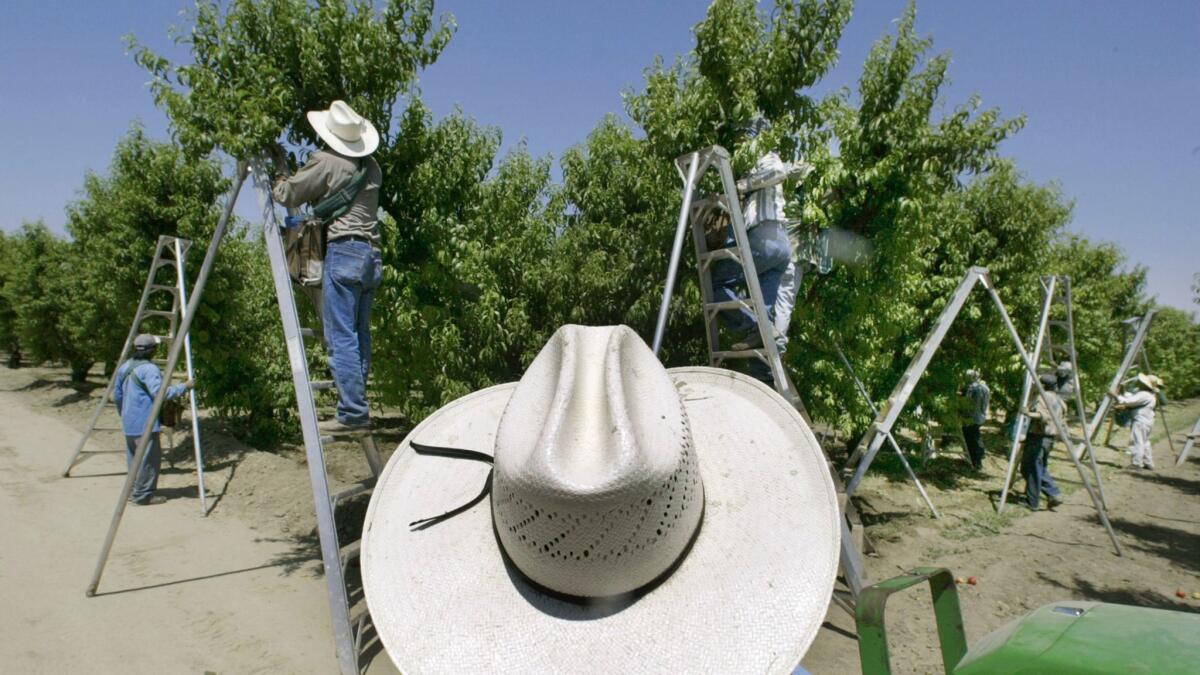Op-Ed: EPA scientists said ban the pesticide chlorpyrifos. Scott Pruitt said no

Miners carried canaries into coal mines; if the canary died it was an early warning of the presence of toxic gases that could also asphyxiate humans or explode. The Trump administration has decided to use children and farmworkers as 21st century canaries, continuing their exposure to a pesticide named chlorpyrifos that has been linked to serious health concerns.
The toxicity of this commonly used pesticide was demonstrated in early May when chlorpyrifos sprayed on a Bakersfield orchard drifted into a neighboring cabbage field, sickening a dozen farmworkers. One was hospitalized.
This is the same chemical that Scott Pruitt, the new administrator of the Environmental Protection Agency, refused to ban in March, despite the advice of EPA scientists.
In November 2016, EPA scientists reported that residues of chlorpyrifos on food crops exceed the federal safety standards for pesticides. Their analysis also found that in areas of extensive but permitted chlorpyrifos use, exposure to the chemical from drinking water exceeds levels safe for human consumption. Workers “who mix, load and apply chlorpyrifos pesticide products,” according to the analysis, face particular risks.
In utero exposures and early life exposures are particularly worrisome because our brains have only one chance to get it right.
Chlorpyrifos is sprayed on turf and on agricultural fields, sometimes close to schools or residential areas. It is used on golf courses, playgrounds, row crops and fruit trees. Those working or playing in these areas come into direct contact with the pesticide.
Those of us who don’t come in direct contact with sprayed locations have likely ingested chlorpyrifos on produce we buy at the supermarket. (Washing produce with water modestly reduces residues; adding vinegar to the water is more effective.) When the pesticide is sprayed, it typically drifts to nearby areas — as demonstrated in the Bakersfield incident — contaminating streams, rivers, drinking water and people.
The health problems associated with chlorpyrifos are varied. It is an endocrine disrupter, which means it could be implicated in breast cancer, and it may also double the risk of lung cancer. It is also one of 12 well-understood and carefully studied neurotoxicants that can adversely affect brain development.
That means it puts children at special risk. In utero exposures and early life exposures are particularly worrisome because our brains have only one chance to get it right. If brain development is disrupted, the result can be greater or lesser lifelong deficits and dysfunctions.
Children are generally more susceptible to adverse effects from toxic substances. An exposure that might not harm an adult will harm a child because of his or her smaller size. In utero, the fetus is vulnerable as its organ systems develop from a few cells to millions of cells. And children have lesser defenses because several protective mechanisms are not as well developed as in adults.
A UC Davis study, based on in-depth surveys of the parents of autistic children in California, found an increased risk of autism spectrum disorder among families living within a mile of agricultural fields during the mothers’ pregnancies. A UC Berkeley study of mothers and children in Salinas identified poorer intellectual development in children resulting from high in utero exposures to chlorpyrifos, including a seven-point drop in IQ, poorer working memory, verbal comprehension and perceptual reasoning by age 7. Even the very architecture of exposed children’s brains changes, according to Columbia University researchers.
When Pruitt overturned the recommendation of the EPA’s scientists regarding the banning of chlorpyrifos he expressed concern that there must be “sound science” about the pesticide’s adverse health effects. Did he not respect the process, the data? He didn’t make it clear.
And hidden in Pruitt’s statement is a worrisome implication: Before banning toxicants — and even perhaps reducing risks associated with them — there must be highly certain, doubt free, ideal evidence about their effects. Anything less and the products can remain on the market.
But that is a choice, one that does not serve the public. Good, highly certain evidence from independent scientists and EPA scientists shows that chlorpyrifos is toxic to people and puts them at risk for serious health effects. Pruitt’s decision favors farmers who want to use the pesticide and companies who want to sell it. It makes those who work in California’s fields or grow up next to them expendable, coal-mine canaries for toxicants that can affect us all.
Carl F. Cranor is a philosophy professor at UC Riverside, specializing in moral choices at the intersection of law and environmental dangers. His books include “Legally Poisoned: How the Law Puts Us at Risk from Toxicants” and “Tragic Failures: How and Why We are Harmed by Toxic Chemicals.
Follow the Opinion section on Twitter @latimesopinionand Facebook
More to Read
A cure for the common opinion
Get thought-provoking perspectives with our weekly newsletter.
You may occasionally receive promotional content from the Los Angeles Times.






